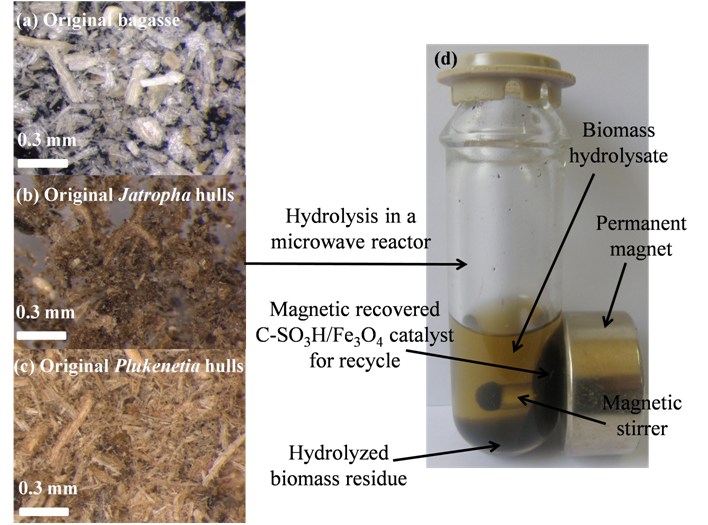Hydrolysis of Selected Tropical Plant Wastes Catalyzed by a Magnetic Carbonaceous Acid with Microwave
星期一, 28 12 月, 2015Many biomass residues are produced in china and it is important to volatilize them, such as conversion of them to sugars by hydrolysis. The hydrolysis of lignocelluloses in concentrated and diluted homogenous acids has been practiced for many years, but problems such as corrosion hazards, acid-waste and difficulties in separation are not solved effectively. Various solid materials, such as transition metal oxides, ion-exchange resins, zeolites and sulfonated carbons are used as environmentally friendly catalysts for biomass hydrolysis because of their reusability, less corrosiveness and non-toxicity. And many magnetization methods are introduced by chemical reactions, such as precipitation and subsequent reduction of Fe3+ to Fe or Fe3O4 which may cause pollution and high cost. In this work, magnetic sulfonated acid was synthesized from glucose and magnetized without chemical reactions by simply mixing magnetic Fe3O4 nanoparticles with aqueous glucose solution.
Miss Tongchao Su (PhD student), under the guidance of Professor Zhen Fang from Xishuangbanna Tropical Botanical Garden (CAS), prepared magnetic catalyst (C-SO3H/Fe3O4) by evaporation the mixture of Fe3O4 nanoparticles and aqueous glucose solution, and pyrolysis in a tubular furnace at temperature of 700 oC for 1 h, and sulfonated by 98% H2SO4 in oil bath at 150 oC for 20 h. The sulfonated sample was washed repeatedly with distilled water at 200 oC for 3 h until no SO4– was detected using CaCl2. C-SO3H/Fe3O4 catalyst had -SO3H, -COOH and -OH acid groups for biomass hydrolysis. Under conditions of 9/50 cellulose/catalyst weight ratio, and 75/1 water/catalyst weight ratio for 3.5 h at 190 oC assisted with microwave, the catalyst was applied to the hydrolysis of bagasse, Jatropha and Plukenetia hulls. For water-ethanol extracted bagasse, Jatropha and Plukenetia hulls, higher yields of total reducing sugars (TRS), glucose and xylose were 79.8%, 58.3%, 97.2%; 47.2%, 35.6%, 96.4% and 54.4%, 35.8%, 94.9%, respectively. The catalyst had a good stability and after seven cycles, it showed no obvious deactivation.
The results are published in Scientific Reports:
TC Su, Zhen Fang*, F Zhang, J Luo, XK Li. Hydrolysis of Selected Tropical Plant Wastes Catalyzed by a Magnetic Carbonaceous Acid with Microwave, 5, 17538 (2015).
微波辅助碳基磁性固体酸水解热带植物废弃物
在中国, 随着经济的发展和人民生活水平的提高,产生出越来越多的生物质废弃物,应该充分利用它们,例如通过水解转化为可发酵糖以生产生物燃料和化学品。多年来,木质纤维素在液体酸中的水解得到广泛地研究和应用。但是设备腐蚀,酸废弃物以及回收问题都没有得到很好地解决。所以,近年来,多种固体催化剂被开发用以水解木质纤维素,例如过渡金属氧化物,离子交换树脂,沸石以及磺化碳等等。固体催化剂能够回收,无毒以及无腐蚀性等优点。通过化学方法沉淀,还原的方法引入磁性物质(Fe3O4)以便于催化剂更好地回收利用。本研究利用葡萄糖和纳米四氧化三铁为原料,通过简单的混合和磺化合成磁性酸催化剂。
中国科学院西双版纳热带植物园生物能源组,博士生苏同超小姐在方真研究员的指导下,通过蒸发四氧化三铁和葡萄糖混和溶液中的水分,然后在马弗炉中700 oC热解碳化1 h,以及在98%浓硫酸中磺化的方法成功合成了C-SO3H/Fe3O4 磁性催化剂。催化剂在使用之前,利用蒸馏水在200 oC水洗3 h直到水洗液中无SO4–基团。C-SO3H/Fe3O4催化剂具有-SO3H, -COOH和-OH酸性功能团,利于水解。在反应温度190 oC, 3.5 h, 9/50生物质和催化剂质量比,以及75/1水和催化剂质量比例条件下,在微波中水解甘蔗渣,小桐子果壳和南美油藤果壳。其中醇-水萃取之后的甘蔗渣,小桐子和南美油藤果壳材料,水解具有较高的产率,其中总还原糖、葡萄糖以及木糖的产率分别为79.8%, 58.3%, 97.2%; 47.2%, 35.6%, 96.4% 和54.4%, 35.8%, 94.9%。此催化剂具有很好地稳定性,催化剂利用七次之后仍无明显的失活。
相关研究成果发表在Scientific Reports上:
TC Su, Zhen Fang*, F Zhang, J Luo, XK Li. Hydrolysis of Selected Tropical Plant Wastes Catalyzed by a Magnetic Carbonaceous Acid with Microwave, 5, 17538 (2015).
图为磁性催化剂C-SO3H/Fe3O4用于在微波水解热带植物废弃物
